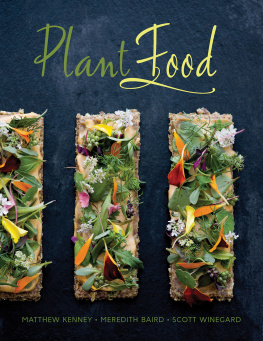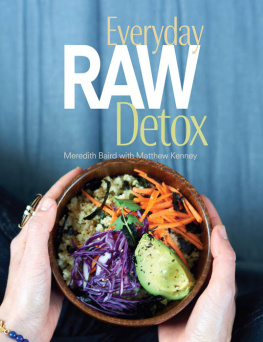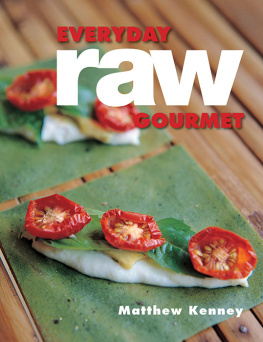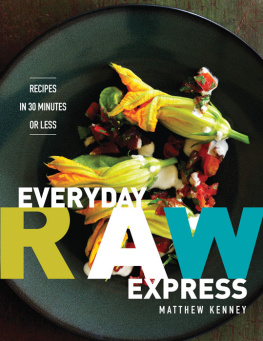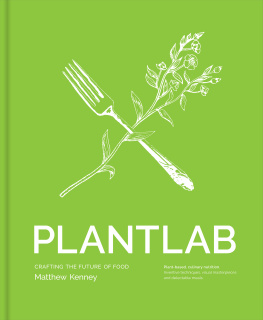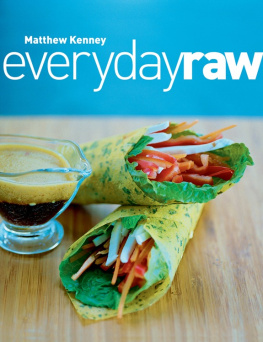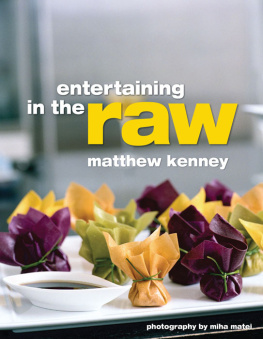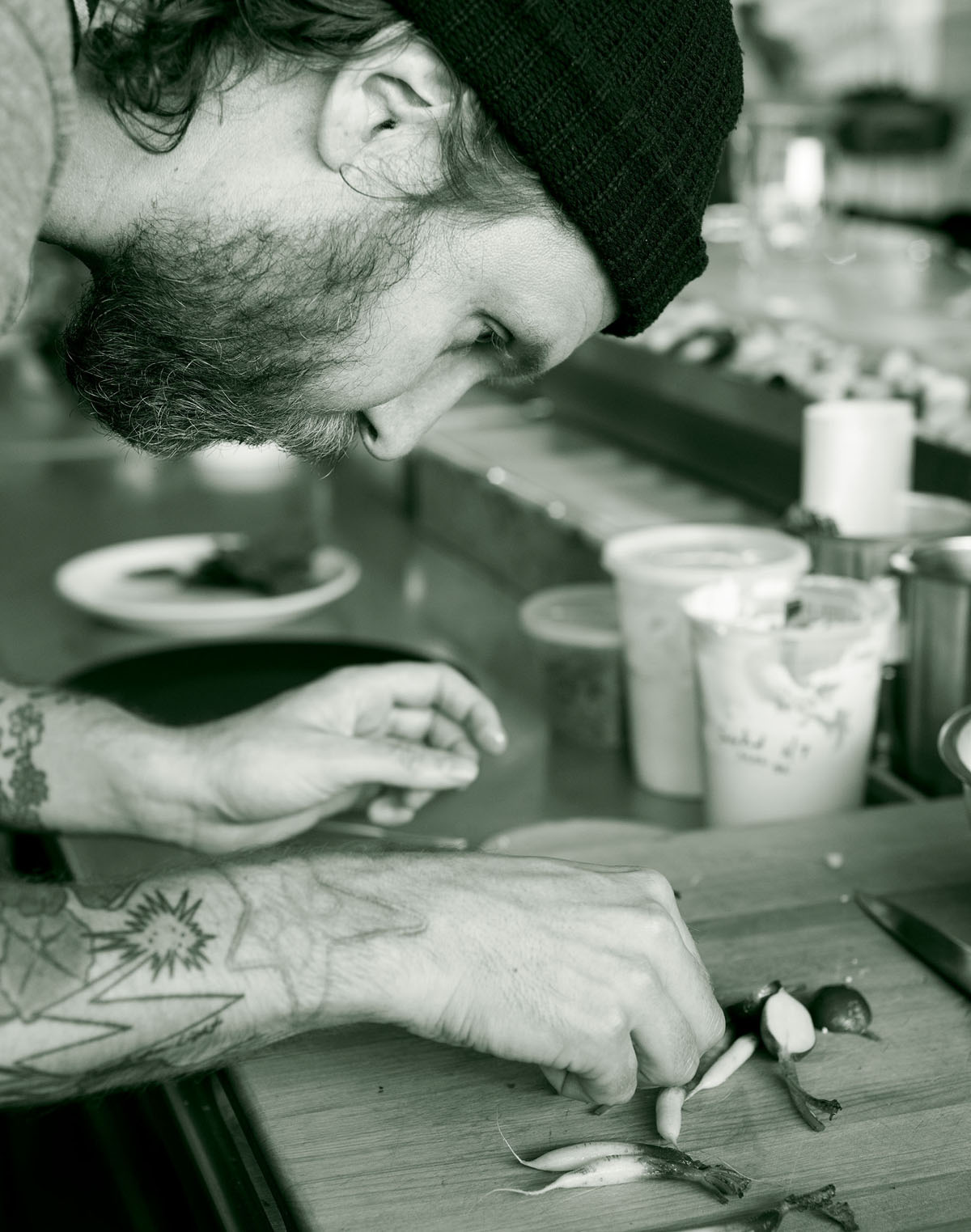Plant Food
Matthew Kenney
Meredith Baird
Scott Winegard
Photographs by Stacey Cramp

Plant Food
Digital Edition 1.0
Text 2014 Matthew Kenney, Meredith Baird, and Scott Winegard
Photographs 2014 Stacey Cramp
All rights reserved. No part of this book may be reproduced by any means whatsoever without written permission from the publisher, except brief portions quoted for purpose of review.
Gibbs Smith
P.O. Box 667
Layton, Utah 84041
Orders: 1.800.835.4993
www.gibbs-smith.com
ISBN: 978-1-4236-3063-0
Acknowledgments
Scott and Meredith, for their relentless creativity and brilliant innovation.
Our teams at M.A.K.E. Restaurant, The White Lotus, Tamazul, and The Gothic.
Megan Dunn and her talented instructors.
Our visionary Leadership Team: Don Fields, James Bartolomei, and Juliana Sobral.
Our Strategic Partners, Tamie and David Posnick.
The extraordinary international community who supports us, especially our wonderful students.
Stacey Cramp, for her magic behind the lens.
Michelle Branson and the team at Gibbs Smith.
Rumple.
Introduction
The new raw food cuisine
Matthew
Raw Update
Well here we are 10 years later and still as passionate about raw food as we were on that Monday evening when I had my first reluctant experience with it. Much has changed! Ingredients we had not heard of at that time are readily available, tools and equipment that were never associated with vegetables are now being applied to plant-based cuisine to create incredible flavor, texture, and color, and a global audience now embraces this all as the food of the future. We couldnt be more excited and also proud to be at the forefront of chefs creating food that is both nutritious and delicious.
It was immediately obvious to me that raw food held the potential to change the culinary landscape, from both an artistic and health perspective. Chefs should have a responsibility to prepare foods that not only taste and look good, but also nourish our bodies and carry a deep respect for the environment. Minimally processed fruits, vegetables, nuts, and seeds (plant foods) provide the quickest path to health and also just happen to taste incredible when prepared with the right ingredients, tools, and skills. Thats where we come in.
We are constantly innovating and developing new techniques, utilizing modern equipment, and choosing the best ingredients to create dishes that will set a new standard for healthy food. Our work has already been a long and persistent journey, but the discoveries and progress we have made allow us to feel confident that raw, plant-based foods now have a structure supporting them that allows people around the world to prepare them properly, with a well-balanced and delicious approach. We believe that this cuisine is the cuisine of the future and that we are close to a tipping point where all credible chefs and those preparing food will respect the responsibility to nourish those enjoying their meals.
As a company, Matthew Kenney Cuisines sole mission is to bridge the gap between culinary art and ultimate nutrition. Everything we do is a step toward this goal. As a result, we apply our energies first and foremost into education. In our culinary schools in Santa Monica, California, Miami, Florida, and online, we have trained hundreds of students from over 40 countries to prepare raw foods in a contemporary, artistic manner that embraces the latest techniques, the best ingredients, and utilizes a structured approach, much like classical French cuisine. This foundation is what will support the growth of the raw food movement in general. Our restaurants serve raw food in settings that resemble any upscale modern dining room, and we cater to clients that range from those utilizing raw food to heal illness to professional athletes interested in enhancing performance. This book is our latest effort to share everything we have learned to allow you to apply those lessons to your own raw foods.
Meredith and Scott
Meredith Baird has coordinated the production of our last several books, including our most recent title, Everyday Raw Detox , which she wrote entirely on her own. She has a gift for translating our work as chefs to a format which is stylish and yet identifiable to the home cook. Her ability to visualize the end result when pairing a talented photographer, innovative chef, and gorgeous cuisine together is a large part of what makes the style of our books so unique. As a student of fashion, food, and design, she is able to meld these various arts together to deliver a final product that is unique to cookbooks.
I first met Scott Winegard in the kitchen at my first raw food restaurant in New York, in 2004. We were both in the early stages of our raw food journey, although we also recognized that it was something about to be big and this was what brought us to the same place. Over the following years, Scott expanded his culinary experience through travel, experimental dinners, and a stage at the worlds number one restaurant, Noma, in Copenhagen. By the time we rejoined, we discovered that our paths were even more aligned than before. We were not only committed to advancing plant-based cuisine, but also to doing it at a level that could compete with any cuisine in the world, not just that made from plants. Scott has applied his unbounded creativity, ingenuity, and talent in such a way that our food has evolved beyond the classicswhile we still love raw lasagna from time to time, the new cuisine does not rely as heavily on its cooked or non-plantbased counterparts, and instead stands on its own for what it is. While his personality comes through clearly from the cuisine, Im also excited to share his insight and quotes throughout the book.
Ive been fortunate throughout my career to work with talented chefs, publishers, and photographers. While our food really is as flavorful and beautiful as it appears on the following pages, this is all a result of the team collectively raising the bar.
Components of Raw Food
The one question Im most often asked is simply, How do you come up with these dishes? Initially, my ideas were so abstract I had a hard time answering the question. These days, I can comfortably answer, Based on three factors, elements, technique, and innovation. These also happen to be the areas that define the cuisine of Plant Food as well.
Elements
We hear it all the time these daysthe importance of quality ingredients, as well as the benefits of seasonal, local, and organic foods. This could not be more applicable than when speaking of plant-based cuisine. If you shop well, you may rarely go into a supermarket, and instead, if you are fortunate to live in areas that offer local farmers markets, you will find yourself bringing home ingredients that have never seen a refrigerator and may have been harvested just hours before. There is no comparison, and this goes for taste, appearance, and health benefits to sourcing local, fresh ingredients. Not only are your efforts to find the best food rewarded in many ways, shopping is also fun, inspiring for those who like to create, and it gets you outside. Enjoy this process!

